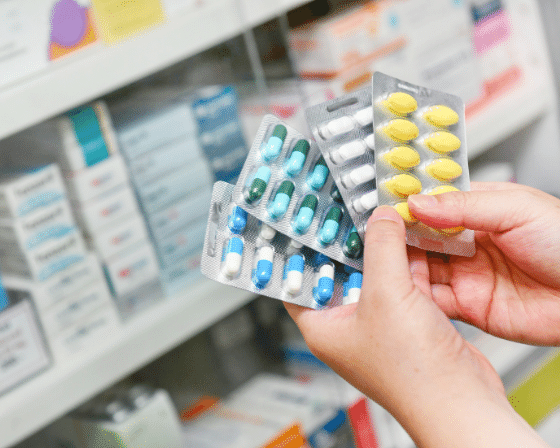Managing diabetes involves a multifaceted approach, including lifestyle modifications, dietary changes, and medication. For many individuals with type 2 diabetes, oral hypoglycemic medications play a crucial role in controlling blood sugar levels. These medications are designed to lower blood glucose levels and reduce the risk of complications associated with diabetes. In this comprehensive guide, we’ll explore the different classes of oral hypoglycemic medications, how they work, their side effects, and other important considerations.
Contents
What are Oral Hypoglycemic Medications?

Oral hypoglycemic medications are drugs taken by mouth to help lower blood sugar levels in individuals with type 2 diabetes. Unlike insulin injections, which are commonly used in type 1 diabetes and sometimes in type 2 diabetes, oral hypoglycemic medications work through various mechanisms to improve insulin sensitivity, decrease glucose production by the liver, or increase insulin secretion by the pancreas.
These medications are an essential component of the treatment regimen for type 2 diabetes, which is characterized by insulin resistance and relative insulin deficiency. By lowering blood sugar levels, oral hypoglycemic medications help prevent hyperglycemia (high blood sugar) and reduce the risk of complications associated with diabetes, such as cardiovascular disease, kidney damage, nerve damage, and eye problems.
Oral hypoglycemic medications are available in several different classes, each with its mechanism of action and potential side effects
Types of Oral Hypoglycemic Medications
Oral hypoglycemic medications are medications taken by mouth to help manage blood sugar levels in individuals with type 2 diabetes. These medications work through various mechanisms to improve insulin sensitivity, decrease glucose production by the liver, or increase insulin secretion by the pancreas. There are several classes of oral hypoglycemic medications, each with its mechanism of action. Some of the main classes include:
Biguanides
Biguanides, such as Metformin, are among the most commonly prescribed oral hypoglycemic medications for type 2 diabetes.
- Metformin works primarily by decreasing glucose production in the liver, thus reducing the amount of glucose released into the bloodstream.
- Additionally, it improves insulin sensitivity in peripheral tissues like muscle and fat cells, enabling them to better utilize glucose.
- Metformin does not stimulate insulin secretion from the pancreas, making it less likely to cause hypoglycemia when used alone.
One of the significant advantages of metformin is its relatively low risk of hypoglycemia compared to some other oral hypoglycemic medications.
- It also tends to promote modest weight loss rather than weight gain, which can be beneficial for individuals with type 2 diabetes who are overweight or obese.
- However, gastrointestinal side effects such as nausea, diarrhea, and abdominal discomfort are common with metformin, especially when initiating treatment or increasing the dosage.
- These side effects usually improve over time or can be mitigated by taking the medication with meals.
Another potential concern with metformin is the risk of lactic acidosis, although this is rare and typically occurs only in individuals with underlying kidney or liver disease. As a result, metformin is contraindicated in patients with significant renal impairment or liver disease.
Sulfonylureas

Sulfonylureas have been used for decades in the treatment of type 2 diabetes.
- Examples include glipizide, glyburide, and glimepiride.
- These medications work by stimulating insulin secretion from the beta cells of the pancreas, thereby increasing the amount of insulin available to lower blood sugar levels.
Also, Sulfonylureas are effective at lowering blood sugar levels and are often used when lifestyle modifications alone are insufficient to control diabetes.
- They can be particularly useful in individuals with significant insulin resistance or those who have preserved pancreatic function.
- However, sulfonylureas carry a risk of hypoglycemia, especially in older adults or those with impaired kidney function who may metabolize these medications more slowly.
Weight gain is a common side effect of sulfonylureas, which can be problematic for individuals who are already overweight or obese.
- Additionally, these medications may lose their effectiveness over time as beta cell function declines in individuals with progressive diabetes.
- Thus, sulfonylureas are often used in combination with other oral hypoglycemic medications or insulin therapy as the disease progresses.
- Certain sulfonylureas, such as glyburide, have a longer duration of action and may be associated with a higher risk of hypoglycemia compared to shorter-acting agents like glipizide or glimepiride.
- Careful dosing and monitoring are essential to minimize the risk of hypoglycemia while optimizing glycemic control with sulfonylureas.
Meglitinides
Meglitinides, including drugs like Repaglinide and Nateglinide, are another class of oral hypoglycemic medications commonly used in the treatment of type 2 diabetes.
- These medications work by stimulating insulin secretion from the pancreatic beta cells, similar to sulfonylureas, but they have a shorter duration of action.
- This rapid onset and short duration make meglitinides particularly useful for controlling postprandial blood sugar spikes, as they can be taken just before meals to stimulate insulin release in response to food intake.
One of the primary advantages of meglitinides is their flexibility in dosing, allowing for individualized treatment based on meal patterns and timing.
- This can be especially beneficial for individuals with irregular eating habits or those who experience significant fluctuations in blood sugar levels throughout the day.
- However, like sulfonylureas, meglitinides carry a risk of hypoglycemia, particularly if taken without adequate carbohydrate intake or if meals are skipped.
Meglitinides are generally well-tolerated, with fewer instances of weight gain compared to sulfonylureas. They are also less likely to cause prolonged hypoglycemia due to their shorter duration of action.
However, their effectiveness may diminish over time as pancreatic beta cell function declines in individuals with progressive diabetes, requiring dose adjustments or combination therapy with other medications to maintain glycemic control.
Thiazolidinediones (TZDs)

Thiazolidinediones, or TZDs, such as Pioglitazone and Rosiglitazone (restricted use due to cardiovascular risks), are oral hypoglycemic medications that improve insulin sensitivity in peripheral tissues such as muscle and fat cells. They activate peroxisome proliferator-activated receptor gamma (PPAR-γ), a nuclear receptor involved in glucose and lipid metabolism.
One of the primary mechanisms of action of TZDs is their ability to enhance insulin-mediated glucose uptake in muscle and adipose tissue, thereby reducing insulin resistance. Additionally, TZDs inhibit lipolysis in adipocytes, leading to decreased free fatty acid levels, which can contribute to insulin resistance.
TZDs are typically used as second or third-line agents in the treatment of type 2 diabetes, either as monotherapy or in combination with other oral hypoglycemic medications.
- They have been shown to improve glycemic control, reduce HbA1c levels, and decrease fasting and postprandial blood glucose levels.
- Additionally, TZDs may have beneficial effects on lipid profiles, with reductions in triglycerides and increases in HDL cholesterol observed with long-term use.
However, TZDs are associated with several potential side effects, including fluid retention, weight gain, and an increased risk of heart failure, particularly with rosiglitazone.
- Pioglitazone has been associated with an increased risk of bladder cancer, although the absolute risk is low and must be balanced against the potential benefits of treatment.
- Due to these safety concerns, the use of TZDs may be limited in certain patient populations, such as those with a history of heart failure or significant fluid retention.
- Close monitoring of fluid status, weight, and cardiovascular risk factors is recommended for individuals receiving TZD therapy to minimize the risk of adverse effects.
Alpha-glucosidase Inhibitors
Alpha-glucosidase inhibitors, such as Acarbose and Miglitol, are oral hypoglycemic medications that work by delaying the digestion and absorption of carbohydrates in the intestine. These medications inhibit the activity of alpha-glucosidase enzymes in the small intestine, which are responsible for breaking down complex carbohydrates into glucose for absorption.
- By slowing the digestion of carbohydrates, alpha-glucosidase inhibitors help to reduce postprandial blood glucose spikes and improve overall glycemic control in individuals with type 2 diabetes.
- They are particularly useful for controlling blood sugar levels following meals and can be taken in combination with other oral hypoglycemic medications or insulin therapy.
One of the key advantages of alpha-glucosidase inhibitors is their low risk of hypoglycemia, as they do not directly stimulate insulin secretion or increase insulin sensitivity. This makes them suitable for use in individuals at risk of hypoglycemia, such as older adults or those with advanced diabetes.
However, alpha-glucosidase inhibitors are associated with gastrointestinal side effects, including:
- flatulence, bloating, and diarrhea, which can limit their tolerability and adherence.
- These side effects are often dose-dependent and may improve over time or with dose adjustments.
- Starting with a low dose and gradually titrating upward can help minimize gastrointestinal symptoms.
Choosing the Right Oral Hypoglycemic Medication

Choosing the right oral hypoglycemic medication for an individual with type 2 diabetes requires careful consideration of several factors, including the person’s medical history, comorbidities, lifestyle, preferences, and potential side effects of the medications. Here are some key points to consider when selecting oral hypoglycemic medications:
Medical History and Comorbidities
- Evaluate the individual’s medical history, including any cardiovascular disease, kidney disease, liver disease, or other conditions that may influence medication selection.
- Certain oral hypoglycemic medications, such as thiazolidinediones (TZDs), may not be suitable for individuals with a history of heart failure due to their potential to exacerbate fluid retention and increase the risk of cardiovascular events.
- Consider medications that have additional benefits beyond glycemic control, such as cardiovascular protection or weight management, in individuals with specific comorbidities.
Risk of Hypoglycemia
- Assess the individual’s risk of hypoglycemia, particularly in older adults, those with renal impairment, or individuals with irregular meal patterns.
- Medications with a lower risk of hypoglycemia, such as metformin or alpha-glucosidase inhibitors, may be preferred in individuals at high risk of low blood sugar episodes.
Lifestyle and Treatment Preferences
- Take into account the individual’s lifestyle factors, such as meal timing, dietary habits, physical activity level, and ability to adhere to medication regimens.
- Consider the dosing frequency and flexibility of different medications, as well as the ease of administration, to align with the individual’s preferences and lifestyle.
Side Effect Profile
- Review the potential side effects of each medication and assess the individual’s tolerance and susceptibility to these adverse effects.
- For example, gastrointestinal side effects such as nausea, diarrhea, and abdominal discomfort are common with metformin and alpha-glucosidase inhibitors, whereas weight gain and hypoglycemia are more prevalent with sulfonylureas and thiazolidinediones, respectively.
Cost and Accessibility
- Consider the cost of medications and insurance coverage, as well as the individual’s ability to afford and access the prescribed medications.
- Generic formulations may be more cost-effective for some individuals, while others may qualify for patient assistance programs or discounts through drug manufacturers.
Individual Response and Glycemic Control
- Monitor the individual’s response to treatment, including changes in blood sugar levels, HbA1c levels, and other markers of glycemic control.
- Adjust the medication regimen as needed based on the individual’s glycemic response and adherence to therapy.
Potential Drug Interactions
- Assess for potential drug interactions with other medications or supplements the individual may be taking, including over-the-counter medications and herbal products.
- Certain oral hypoglycemic medications, such as sulfonylureas, may interact with other drugs, such as certain antibiotics or anticoagulants, increasing the risk of adverse effects or altering their efficacy.
Conclusion
Oral hypoglycemic medications are valuable tools in the management of type 2 diabetes, helping to improve glycemic control and reduce the risk of complications. Understanding the different classes of oral hypoglycemic medications, their mechanisms of action, side effects, and considerations for selection and monitoring is crucial for healthcare providers and individuals with diabetes alike.
By working closely with healthcare providers and adopting healthy lifestyle habits, individuals with diabetes can effectively manage their condition and lead fulfilling lives.
Do you want to get rid of diabetes? Join our online diabetes treatment program and reverse Diabetes naturally through lifestyle changes such as a Personalized Diet plan, Exercise, Yoga, dieticians, and health coaches.

